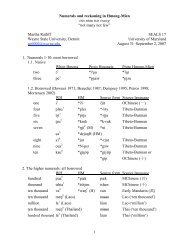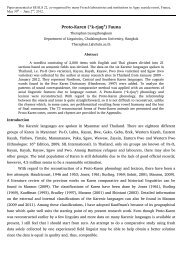proto-southwestern-tai revised: a new reconstruction - seals 22
proto-southwestern-tai revised: a new reconstruction - seals 22
proto-southwestern-tai revised: a new reconstruction - seals 22
Create successful ePaper yourself
Turn your PDF publications into a flip-book with our unique Google optimized e-Paper software.
Mon Particle kɔ̀h 67<br />
It appears that kɔ̀h does have some of the semantic properties of a definite article,<br />
but it can hardly be seen as a grammaticalised marker of definiteness, unless we are ready<br />
to accept a more vague definition of definiteness than the one given by Lyons. The fact<br />
that kɔ̀h is used to mark a verbal expression as an argument rather than the predicate<br />
indicates that there is a possible connection with the topic – comment distinction, i.e. kɔ̀h<br />
might be used to mark topics. This means that the function of kɔ̀h is one of information<br />
structure rather than syntax or semantics. To this topic we will turn in the next section.<br />
5. Information structure – Topic and focus<br />
5.1 Topicality<br />
Different authors have suggested different definitions of the term ‘topic’. Haiman gives the<br />
following definition:<br />
The topic represents an entity whose existence is agreed upon by the speaker and his<br />
audience. As such, it constitutes the framework which has been selected for the<br />
following discourse. (Haiman 1978:585)<br />
Dik states that “a linguistic expression will [...] usually con<strong>tai</strong>n some given information and<br />
some <strong>new</strong> information” (1989:265ff). Given information is what the speaker assumes to be<br />
available to the addressee as pragmatic information, which consists of “general,<br />
situational, and contextual information” (Dik 1989:9, 265). He goes on that “partially<br />
corresponding to the “given”/”<strong>new</strong>” distinction, we may distinguish the dimension of<br />
topicality and focality” (p. 266). Topicality tends to coincide with given information, and<br />
focus with the most salient or important piece of <strong>new</strong> information that is given about the<br />
topic.<br />
Dik distinguishes different kinds of topics: The discourse topic denotes the entity<br />
which the discourse is “about”. A discourse may have different discourse topics with<br />
different degrees of centrality to the discourse. While a topic usually refers to an entity that<br />
is known or given, i.e. mentioned in the previous discourse (“GivTop”, Dik 1989:267),<br />
<strong>new</strong> referents may be introduced to the discourse as “NewTop” (ibid.). A NewTop denotes<br />
an entity that is not mentioned before but that is relevant to the following discourse. A<br />
topic can be reactivated after a stretch of discourse. It is then called a “resumed topic”<br />
(ResTop; ibid.).<br />
Other authors (e.g. Erteschik-Shir 2007:) take up the features of topic a “givenness”<br />
and “aboutness”. Givón (2001:254) states that “topicality involves two aspects of<br />
referential coherence, one anaphoric, the other cataphoric”. The anaphoric aspect is<br />
“referential accessibility” and the cataphoric aspect is “thematic importance”.<br />
Lambrecht (1994) says that in his use of the term, “the topic of a sentence is the<br />
thing which the proposition expressed by the sentence is ABOUT” (p.118). Also, the topic<br />
must be relevant to the present discourse and the predicate must add some <strong>new</strong> information<br />
about it. “The definition of topic in terms of aboutness and contextual relevance en<strong>tai</strong>ls that<br />
there is an inherent relationship between topic and pragmatic PRESUPPOSITION” (p. 150).<br />
That means according to Lambrecht’s definition, the topic is part of the presupposition of<br />
the utterance. This is related to the pragmatic (or information-structural) status of the NP<br />
referred to by the topic expression. Lambrecht (p. 109) distinguishes different degrees of<br />
identifiability:





